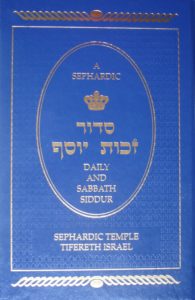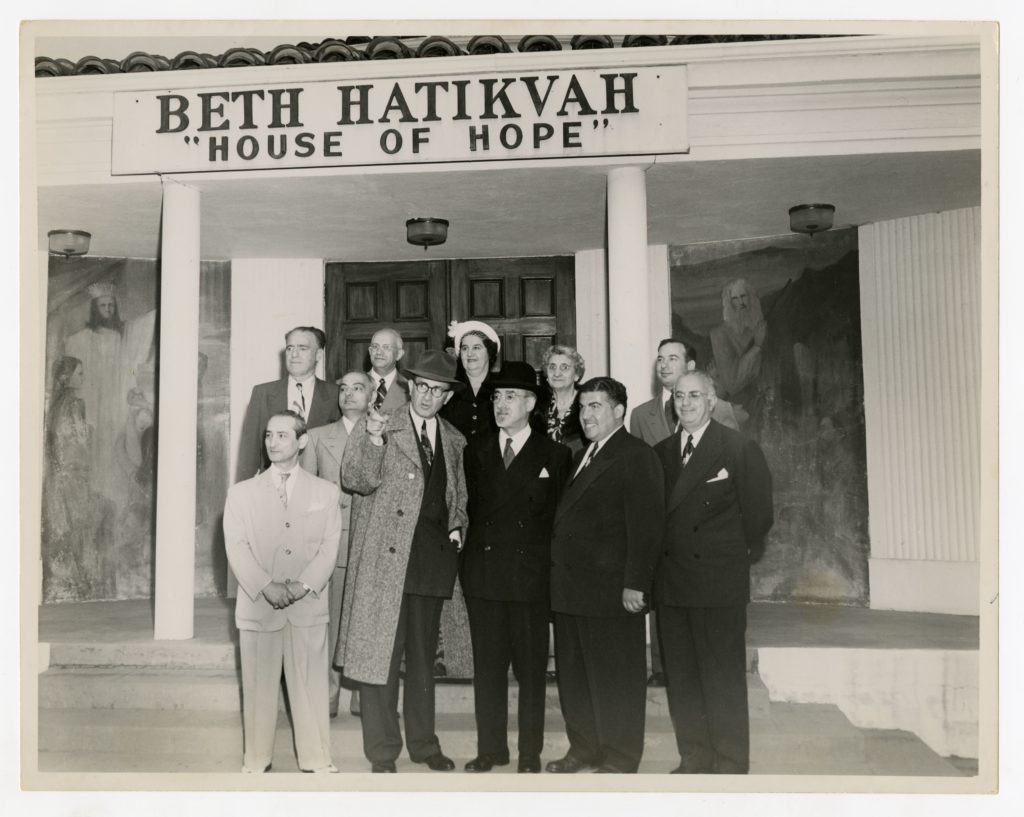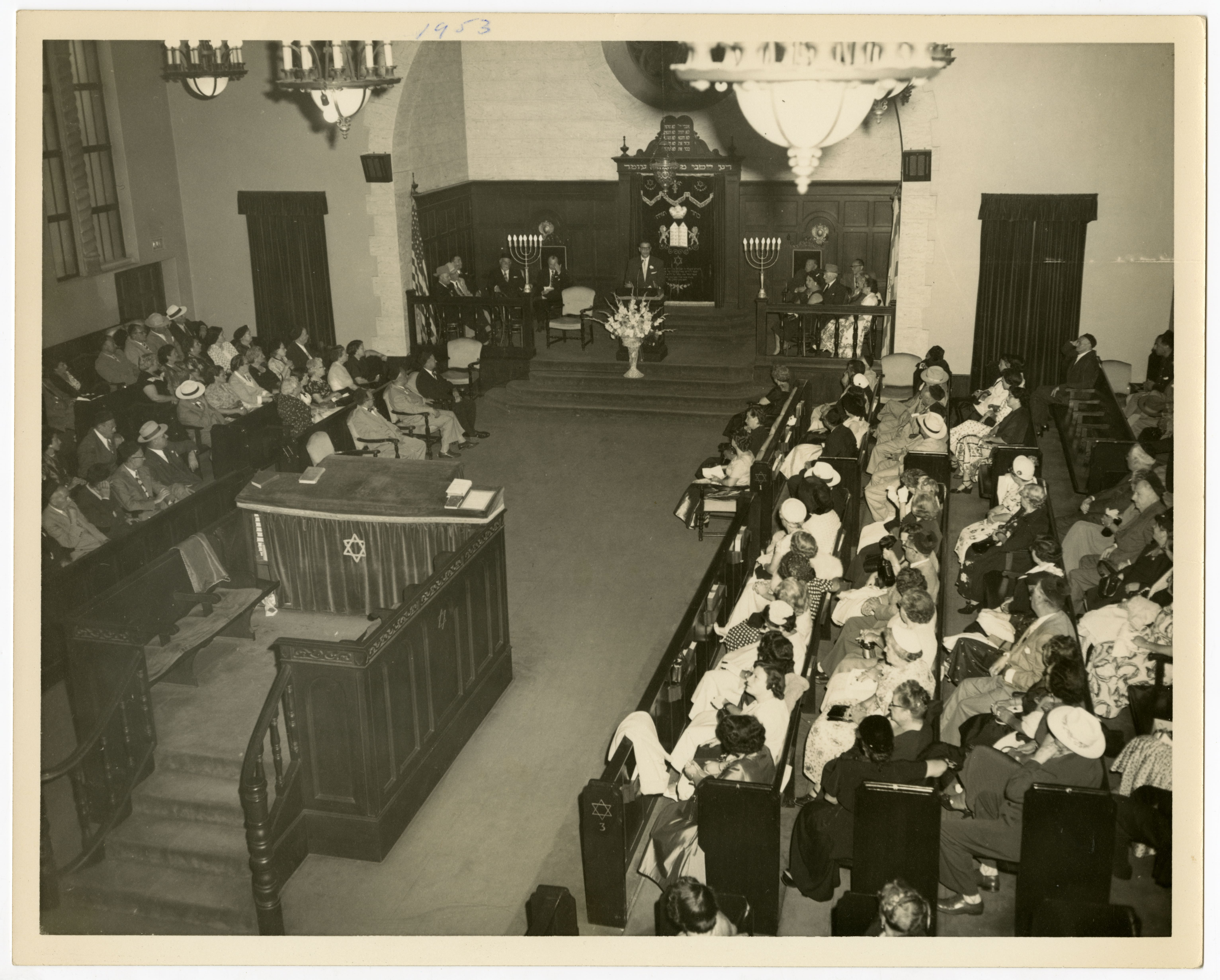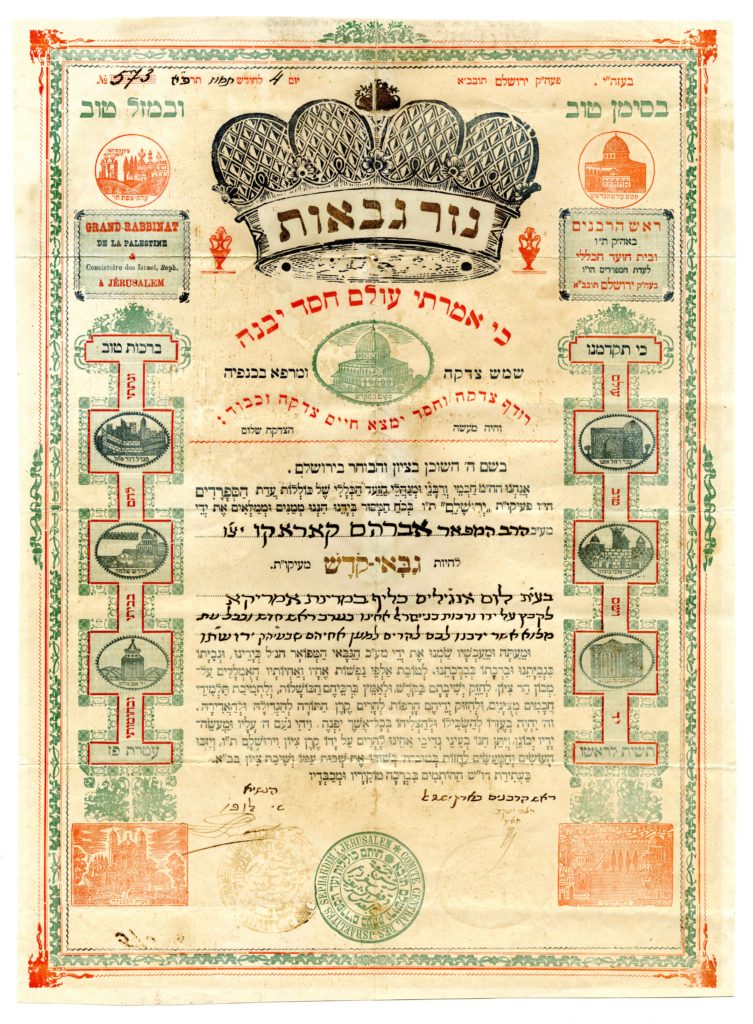


In 2015, Sephardic Temple Tifereth Israel in Los Angeles placed an order for 1,000 new prayer books, the Siddur Zehut Yosef: A Sephardic Daily and Sabbath Siddur, published several years earlier in Seattle by Hazzan emeritus Isaac Azose. Like Sephardic congregations in Seattle and around the U.S. with roots in the Ottoman empire, Temple Tifereth Israel had long utilized prayer books that fit awkwardly in their religious services – siddurim in the Spanish-Portuguese custom belonging to Northern European Sephardi immigrants rather than to those like themselves with ancestral roots around the Mediterranean and the Middle East. European-origin Sephardim had been the first to immigrate to the United States beginning in the seventeenth century, eventually establishing synagogues and communal institutions well in advance of influxes of Mediterranean-region Sephardim at the turn of the twentieth century. Bolstered by their superior institutional resources and European provenance in an ethnically stratified American Jewish community, European-origin Sephardic institutions in New York City – Congregation Shearith Israel and the Union for Sephardic Congregations – disseminated the David de Sola Pool’s Daily and Sabbath Book of Prayers beginning in the mid-1930s to homogenize under the Spanish-Portuguese rubric diverse Sephardi immigrant practice throughout the United States.
“We were unified,” Hazzan emeritus Isaac Azose later remarked, “but not happy.”1 Indeed, his boyhood congregation, Sephardic Bikur Holim in Seattle, had uneasily used the de Sola Pool prayer book for decades by pasting locally produced texts between its pages and making impromptu oral modifications during services. After a lengthy research and editing process, Azose published the more suitable Siddur Zehut Yosef in 2002, which eventually made its way from Seattle to Los Angeles in 2015. “They love it,” commented the Sephardic Temple Tifereth Israel member who facilitated the sale.“We should have bought them a long time ago.”2 The new siddur based on collective memory of Seattle prayer practices now joins four other prayer books, also compiled by Azose, to serve not only communities originally identified with late Ottoman Sephardic immigrants but also North American and overseas congregations richly diversified through subsequent waves of Jewish immigration from North Africa and the wider Middle East.

One of the unique features of Siddur Zehut Yosef is its incorporation of Turkish and Rhodes customs in tune with the ancestry of its congregational users in Seattle. Like Seattle’s two synagogues (Sephardic Bikur Holim and Congregation Ezra Bessaroth), Sephardic Temple Tifereth Israel in Los Angeles also accommodated immigrants from the Turkish mainland and the island of Rhodes beginning in 1994, when the temple merged with the local Rhodes-based synagogue, Sephardic Beth Shalom. Azose’s Siddur Zehut Yosef distinguishes between Rhodes and Turkish traditions by marking sections throughout the text with distinctive editorial codes, {R} and [T] for Rhodes and Turkish practices respectively. In addition, it contains Hebrew, English, and extensive Ladino sections, as well as significant additions not contained in the de Sola Pool edition. These additions include all Monday and Thursday Torah readings, the name list for use at the conclusion of the amidah’, collections of pizmonim, or hymns, portions of the service traditionally recited in Ladino, and instructions (in Ladino) for the selling of the mitzvot (the Sephardic custom of auctioning the honors of taking out the Sefer Torah during services). Several alterations were made to comply with specific requests by Temple Tifereth Israel, including the Berich Shemeh in Ladino (page 234) and prayers for both the government and the U.S. armed forces (page 234A). Members of the L.A. Temple were so enthused about the new siddur that two years later in 2017, they ordered 1,000 copies of Azose’s Mahzor Zichron Rahel for the festivals of Sukkot, Passover, and Shavuot.
Isaac Azose leads Passover in “Song of the Sephardi,” directed by David T. Raphael, 1978.
Temple Tifereth Israel in Los Angeles is hardly the first customer for Azose’s prayer books but rather joins a growing synagogue network seeking prayer books more fitting to their historical practices than the Spanish-Portuguese custom. Just two years after the publication of the first edition of Siddur Zehut Yosef for Sephardim in Seattle, a synagogue in Rockville, Maryland (Magen David Sephardic Congregation) with members of Iraqi, Syrian, and Moroccan descent ordered a shipment of prayer books with an English rather than Ladino translation of Pirke Avot (“Sayings of the Fathers”), a request that led to a new alternate edition and the beginnings of wider sales and dissemination of the siddur. Entering a second edition in 2012, the siddur began to fill the liturgical needs of congregations in other states such as California, Georgia, Indiana, Oregon, and Maryland, necessitating the removal of its original localizing (“Seattle Sephardic Community”) moniker. These congregations include Ladino-speaking Sephardim as well as Moroccan, North African, Levantine, Iranian, and Iraqi members, collectively embodying the complex layers of successive Jewish immigration, particularly after World War II and the establishment of the State of Israel. Their memberships reflect how diverse American Sephardim have become, as post-war immigrants from the Middle East and West Asia have eclipsed eastern Mediterranean immigrants of the early twentieth century from such areas as Rhodes, the Balkans, and the Turkish mainland. Magen David Sephardic Congregation in Rockville exemplifies changing demographics within a single synagogue across the twentieth century, as its original majority from Turkey and Greece gradually gave way to Moroccan, North African, and Middle Eastern membership after 1940. Within this rich diversity Azose continued to take orders from congregations in the U.S. and abroad, including South Africa (Cape Town and Johannesburg) and Greece (Rhodes). Over the years he has compiled and published four additional prayer books–Mahzor Zichron Rahel (for the festivals of Sukkot, Passover, and Shavuot), Mahzor Tefilah LeDavid (for Rosh Ashana), Siddur Tefilah LeMoshe (for the Five Fast Days) and Mahzor Kol Yaakov (for Yom Kippur)–all of which have been adopted in Seattle and other regions.

The apparent divide among American Sephardim between “Eastern” and “Western” Sephardic prayer books, edited by Isaac Azose and David de Sola Pool respectively, masks historical continuities between divergent émigré communities after the Spanish Inquisition. The disparate streams of exiles–from the majority settling in the Ottoman empire (especially Salonica, Istanbul, and Izmir) to the lesser numbers creating Spanish-Portuguese centers in Northern Europe (especially Amsterdam, Hamburg, and London)–actually shared an early modern Mediterranean past. If we travel back to 1600, for example, we find the community in Amsterdam looking southward toward the more well-established congregations in the Ottoman Empire, North Africa, and Italy for institutional models, publications, and religious personnel. A number of hazzanim were hired from the Salonica/Venice region in the early seventeenth century, among them Joseph Pardo and his son David as well as R. Saul Levi Mortera and Joseph Shalom Gallego. In fact, Joseph Pardo’s grandson, Saul Pardo, became the very first Sephardi hazzan in New York later in the century. In addition, liturgical poets like Isaac ben Abraham Uziel from Fez and Israel Najara from Safed journeyed south to north either in person (Uziel) or through publications of piyyutim (Najara). The piyyut Lekhah Dodi, composed by sixteenth-century Salonican poet Shlomo Halevi Alkabetz, testifies to the widespread circulation of Ottoman Jewish mystical compositions among post-Inquisition Sephardi settlements given its commonplace usage in diverse communities up to the present-day.

Although religious and intellectual exchange continued among Sephardic centers in Europe and the Ottoman empire, the ensuing centuries saw the regional acculturation of communities to their respective societies–acculturations that would eventually represent the diverse liturgical patrimony of Sephardim on American soil, as immigrant editors like Azose and de Sola Pool looked toward distinctive “homelands” defined by the post-Inquisition trajectories of ancestors. Of particular interest to regionally shaped liturgies is the integral involvement of Ottoman and Northern European Jews in ambient art music, which, linked to court culture and high musical learning, projected a status considered fitting for diverse houses of worship, including synagogues. Ottoman Jewish musicians, for example, passed fluidly among court, synagogue, and other music-making spaces, helping to constitute synagogue music in general and specifically developing a paraliturgical Maftirim repertoire paralleling in Jewish religious space the Ottoman court suite. Historical visitations between Jewish and Mevlevi (whirling dervish) musicians, the Sufi brotherhood of the court and aristocracy, also informed music-making in the synagogue through Jewish contact with some of the most complex of imperial music, the Mevlevi ceremony (ayin).

As a case in point, Reverend Samuel Benaroya, one of Isaac Azose’s teachers, who grew up in late Ottoman Edirne and served as hazzan at Seattle’s Sephardic Bikur Holim for thirty years, was steeped in Ottoman music as a boy, visiting the Mevlevi lodge regularly with his uncle and learning music there. In contrast to the largely monophonic (not harmonized) Ottoman Jewish religious music, in Northern Europe art music by both Jewish and non-Jewish composers provided the Spanish-Portuguese congregations with a corpus of typically polyphonic (harmonized) music for their congregations. Some of these compositions were commissioned for Jewish holidays, with certain numbers becoming traditionalized by hazzanim as cantorial solos and with five-staff notation facilitating the development of harmonized arrangements of “ancient” Sephardic melodies by the nineteenth century. Spanish-Portuguese congregations in Hamburg, Amsterdam, and London were also touched by nineteenth century Jewish reform movements introducing choirs and organs into synagogues. Indeed, across the Atlantic in twentieth century New York, Shearith Israel featured an organ reportedly donated by George Gershwin and boasted a male choir that David de Sola Pool extolled as the force behind the “beauty and dignity” and “high musical character” of the services at the synagogue.

Regional divergences between Ottoman and European art music cultures and prayer book publication, in the end, eclipsed a shared Sephardic Mediterranean past in shaping Sephardic communal identifications on American soil. With the advantage of long-time American-assimilated institutions and Anglo-European civilizational status, New York’s Spanish-Portuguese religious bodies, led by de Sola Pool, held sway among Sephardim nation-wide for a period of time, as they pursued a unifying mission through a national prayer book reflecting a Northern European cultural genealogy “pruned” of what could be called a common Mediterranean ancestry. This initial institutional advantage, however, failed to claim liturgical winners or losers. “The exact opposite” happened from what de Sola Pool and the Union of Sephardic Congregations expected, according to Azose: in place of the homogenization of diverse liturgical practices from the Mediterranean region, historical local diversity is flourishing in the United States.3 By orally altering national prayer books since the mid-twentieth century, Seattle emerged as a viable local publishing center, which has generated its own orbit of diverse liturgical kith and kin in a changing immigrant landscape. Its newest customer, Sephardic Temple Tifereth Israel, historically shares the Turkish and Rhodes membership that characterizes Seattle’s two synagogues and inspired the editorial richness and specificity of Siddur Zehut Yosef. Temple Tifereth Israel joins other Middle Eastern and North African congregations in the United States as well as abroad that represent the increasingly diversified mix of Jewish immigrant communities in the twenty-first century finding a liturgical home in Seattle’s Sephardic prayer books. Even in their linguistic and regional diversity, these communities effectively braid themselves into an eastern Mediterranean liturgical line of descent for which the Seattle community, endowed now with its own longevity, knowledge, and financial resources, has forged a path.
Citation MLA: Jackson, Maureen. “Praying on the Pacific.” 100 Years of Sephardic Los Angeles, in ed. Sarah Abrevaya Stein and Caroline Luce, UCLA Leve Center for Jewish Studies, 2020, https://sephardiclosangeles.org/portfolios/praying-on-the-pacific/.
Citation Chicago: Jackson, Maureen. “Praying on the Pacific.” In 100 Years of Sephardic Los Angeles, edited by Sarah Abrevaya Stein and Caroline Luce. Los Angeles: UCLA Leve Center for Jewish Studies, 2020. https://sephardiclosangeles.org/portfolios/praying-on-the-pacific/.
About the Author:
Maureen Jackson’s research explores Jewish and multiethnic musical cultures in the Ottoman Empire and Turkey as a lens for understanding cultural, economic, and political history… More
Citations and Additional Resources
1 Isaac Azose, personal interview with Maureen Jackson, Jan. 29, 2019.
2 As reported by Isaac Azose, personal interview with Maureen Jackson, Jan. 29, 2010.
3 Isaac Azose, personal communication with Maureen Jackson, 2005.
If you have any more information about an item you’ve seen on this website or if you are the copyright owner and believe our website has not properly attributed your work to you or has used it without permission, we want to hear from you. Please email the Leve Center for Jewish Studies at cjs@humnet.ucla.edu with your contact information and a link to the relevant content.
